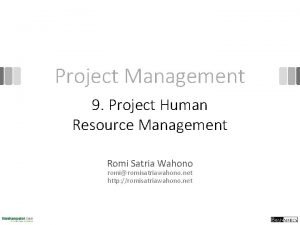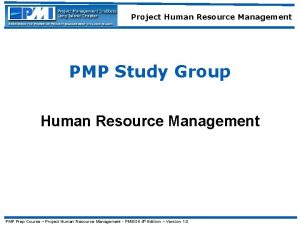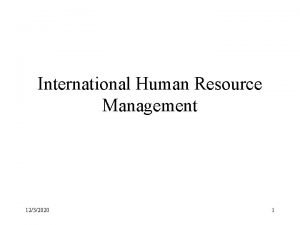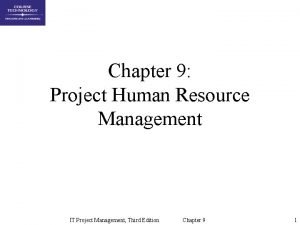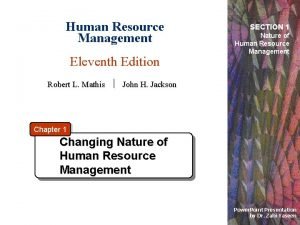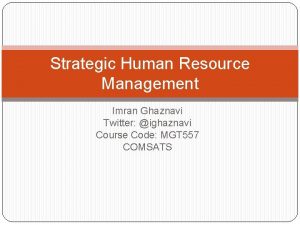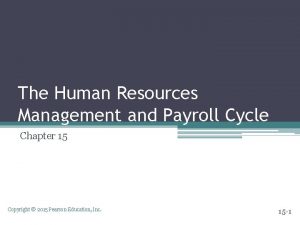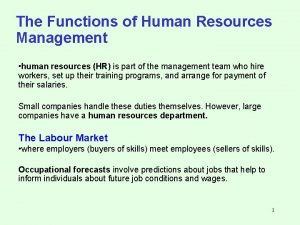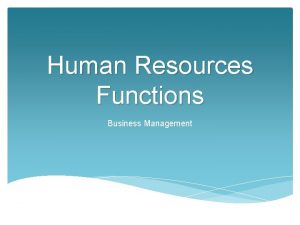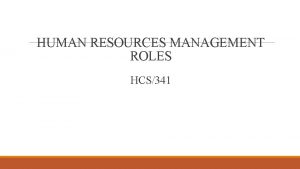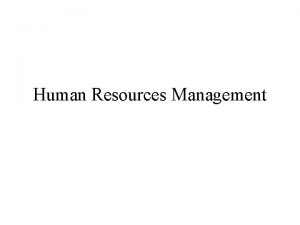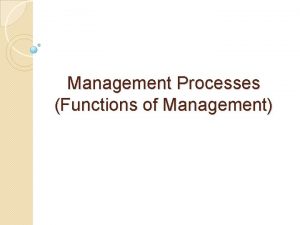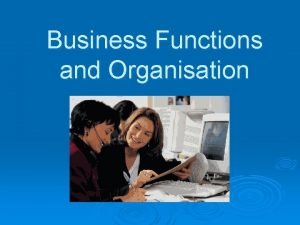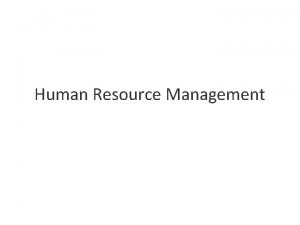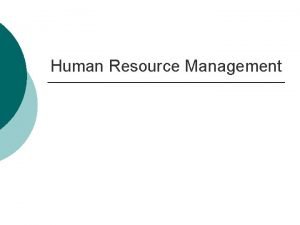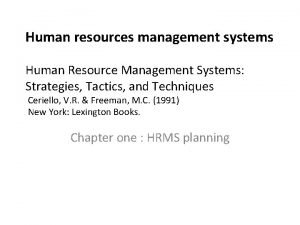11 Human resources management I Functions of Human

















- Slides: 17

11. Human resources management I • Functions of Human Resource Management – planning; – recruitment; – selection; – compensation; – training and development; – labour relations; – separations.

Line and HR manager cooperation planning; selection; compensation; development; firing.

Attitudes and personality Big five personality factors: – extroversion – the degree to which a person is outgoing, sociable, assertive… – agreeableness - the degree to which a person is cooperative, likable, understanding… – conscientiousness – the degree to which a person is focused on new goals, responsible, persistent… – emotional stability – the degree to which a person is calm, enthusiastic, self-confident – openness to experience – the degree to which a person has a broad range of interest, is creative…

Motivation – Hierarchy of Needs Theory (Maslow) – physiological, safety, belongingness, esteem and self-actualization needs – ERG Theory (Alderfer) – existence, relatedness and growth needs; – Two-factor Theory (Herzberg) – hygiene factors and motivators; – Aquired Needs Theory (Mc. Clelland) – Need for Achievement, for Affiliation and for Power; – Equity Theory (Adams) – process theory; how fairly we consider the reward in comparison to our colleagues’ rewards. – Expectancy Theory (Vroom) – process theory; motivation depends on individual’s expectations about their ability to perform tasks and receive desired reward. Motivation is the arousal, direction, and persistence of behaviour (Daft, 2008, p. 522).

Stimulation Reinforcement tools – Positive reinforcement, – Avoidance learning, – Punishment , – Extinction. – Job design (simplification, rotation, enlargement, enrichment)

Factors influencing working performance • adequately competitive environment in company • physical and another conditions of workplace • easiness of communication • actual conditions of personal life • rules and methods of managment

Evaluation Criterions • work results – amount of work, quality of work, • work behaviour – tasks acceptation willingness, own initiative, instruction adherence, and also self-reliance, creativity, reliability • social behaviour – partnership willingness, styl of behaviour and superiors´ managing • education and skills 7

work results • objectivness • easy to monitor • hard to specify – repairer, employees in services, chemistry, … 8

work behaviour • punctuality • number of working hours • willingness of take over tasks • reliability 9

social behaviour • employees working with other people • managers • risks of this evaluation – it is easy to compare the similarity of evaluator and evaluee personality. 10

education and skills • often it is not relevant • managers – competence (real cope of work tasks) – interpersonal – necessary in people management, – technical – connected with coping of immediately superiors work, – conception – strategic thinking, vision, … 11

Performance influenced factors • positive • negative To evaluate the performance not employee! 12

Appraisal interview • preparation – both evaluator and evaluee, • form – with list and description of criterions, both sides fill it in advance and then discuss about it, • subconcious tendencies – are in each evaluation, it is suitable to know them and minimize them. Employee Evaluation as a Quality Management Aspect 13

Subconscious tendencies in appraisal – first impression, – effect of order, – affection (attraction), – societal position symbols, – contrast of getting grey, – projection, – horns effect, – black and white seeing – comparison with oneself 14

Modern trends • 360 degree feedback – global appraisal • hard installation and realization • but relevant results. 15

360 degree feedback • to know or change my behaviour • principle - multi-rater evaluation technique Colleagues Superior Selfevaluation Customers Inferiors 16

Advantages and Disadvantages • multi-rater evaluation should be more objective • personal development • only general rules for instalation • correct motivation of evaluators is necessary • long time for evaluation and analysis of data 17
 Human resource histogram
Human resource histogram Project management human resources
Project management human resources Job expansion in operations management
Job expansion in operations management Hrm importance
Hrm importance Empower human resources
Empower human resources Resource management definition
Resource management definition Chapter 9 human resources management
Chapter 9 human resources management Human resource management question paper
Human resource management question paper Retail org chart
Retail org chart Intro to human resource management
Intro to human resource management Human resource management weiterbildung
Human resource management weiterbildung Human resources management gaining a competitive advantage
Human resources management gaining a competitive advantage Chapter 9 human resources management
Chapter 9 human resources management The nature of hrm
The nature of hrm Time management human resources
Time management human resources Explain the concept of human resource management
Explain the concept of human resource management Advantages of external recruitment
Advantages of external recruitment Payroll cycle activities
Payroll cycle activities
